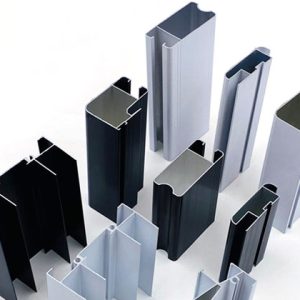Descrizione
6061 e 6063 are two common types of profili in alluminio used in various industries.
6061 aluminum profiles are known for their strength, durabilità, e resistenza alla corrosione. They are often used in applications where high strength and stiffness are required, such as aerospace, settore automobilistico, and structural engineering. 6061 aluminum profiles have excellent machinability and can be easily welded, making them a popular choice for custom fabrication.
6063 profili in alluminio, d'altro canto, are known for their excellent finishing properties and aesthetic appeal. They are often used in applications where appearance is important, such as architectural and decorative applications. 6063 aluminum profiles have good corrosion resistance and are easy to extrude, making them a popular choice for custom extrusions.
Entrambi 6061 e 6063 profili in alluminio are versatile and can be used in a wide range of applications. The choice between the two depends on the specific requirements of the application, such as strength, durabilità, and appearance.
As a leading manufacturer of advanced and highly specialized aluminum extrusions profiles. Offriamo una gamma di profili in alluminio personalizzati, estrusi in alluminio, e grande estrusione strutturale. I profili in alluminio sono ideali per le costruzioni nella costruzione di macchine e impianti. Il grande vantaggio è il peso ridotto dei profili e una tecnologia di connessione flessibile.
6061 6063 Profili in alluminio manufacturer RAYIWELL MFG from China. Profili in alluminio can be divided into 1024, 2011, 6063, 6061, 6082, 7075 e altri gradi di lega di profili in alluminio, di cui 6 la serie è la più comune. La differenza tra i diversi gradi è che il rapporto tra i vari componenti metallici è diverso, except for commonly used profili in alluminio for doors and windows In addition to architectural aluminum profiles such as 60 serie, 70 serie, 80 serie, 90 serie, e serie di facciate continue, non esiste una chiara distinzione di modello per i profili industriali in alluminio, e la maggior parte dei produttori li elabora in base ai disegni effettivi dei clienti.
Profili in alluminio avere tale trattamento superficiale
1. Alluminio anodizzato
2. Rivestimento elettroforetico di alluminio
3. Alluminio verniciato a polvere
4. Alluminio per trasferimento di venature del legno
5. Alluminio spruzzato al fluorocarbonio
6. Alluminio lucidato (suddiviso in lucidatura meccanica e lucidatura chimica, tra cui la lucidatura chimica ha il costo più alto e il prezzo più alto)
Profili in alluminio are products born from aluminum alloys that are transformed into shaped objects through the extrusion process. La combinazione unica di caratteristiche fisiche dell'alluminio dipende principalmente da questo processo. Le estrusioni di alluminio sono utilizzate in diversi campi perché questo metallo lo è: Forte e stabile.
Tipi di profili in alluminio
- Trave cava.
- Profilo quadrato.
- Profilo in alluminio SD.
- Profilo RCW.
- Sezione porta.
- Profilo della feritoia.
- Sezione a T
-
Lega e Fe con Mn mg Cr Zn Ti Impurity Al Unit Totale 6063 0.2-0.6 <0.35 <0.1 <0.1 0.45-0.9 <0.1 <0.1 <0.1 <0.05 <0.15 Surplus 6061 0.4-0.8 0.7 0.15-0.4 <0.15 0.8-1.2 0.04-0.35 <0.25 <0.15 <0.05 <0.15 Surplus 6005 0.6-0.9 <0.35 <0.1 <0.1 0.4-0.9 0.1 <0.1 <0.1 <0.05 <0.15 Surplus 6060 0.3-0.6 0.35-0.6 0.1-0.3 <0.1 <0.1 <0.15 <0.05 <0.1 <0.05 <0.15 Surplus - Usi tipici di 6061 Representative applications include aerospace fixtures, impianti elettrici, comunicazioni, and are also widely used in automated mechanical parts, lavorazioni meccaniche di precisione, fabbricazione di stampi, elettronica e strumenti di precisione, SMT, PC board soldering vehicles, eccetera.
Alluminio products made of aluminum and other alloying elements. Di solito viene trasformato in fusioni, forgiati, fogli, piatti, strisce, tubi, canne, profili, eccetera., e poi lavorato mediante piegatura a freddo, segare, perforazione, montaggio, e colorazione. L'elemento metallico principale è l'alluminio, aggiungendo alcuni elementi in lega per migliorare le prestazioni dell'alluminio
Aluminum profile extrusion is a manufacturing process that involves the creation of complex shapes and designs using aluminum as the primary material. The process involves forcing molten aluminum through a die, which is a specially designed tool that shapes the aluminum into the desired profile.
The aluminum profile extrusion process begins with the creation of a die, which is typically made from steel or some other durable material. The die is designed to produce the desired shape or profile of the finished product. Once the die is created, it is mounted on a press and heated to a temperature that is high enough to melt the aluminum.
The aluminum is then loaded into a hopper, which feeds it into the press. The press applies pressure to the molten aluminum, forcing it through the die. As the aluminum passes through the die, it is cooled and solidified, forming the desired shape or profile.
After the aluminum has been extruded, it is cut to the desired length and may undergo additional processing such as surface finishing, machining, or assembly. The resulting aluminum profiles can be used in a wide range of applications, compresa la costruzione, settore automobilistico, aerospaziale, and consumer products.






-
-
-